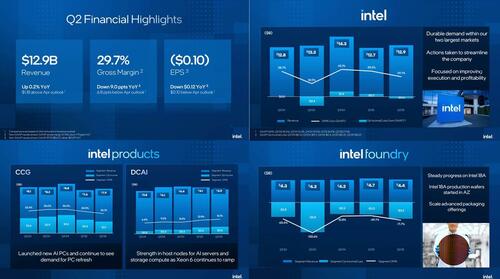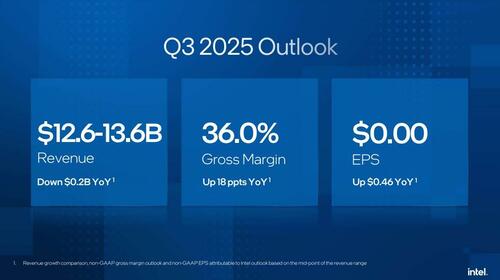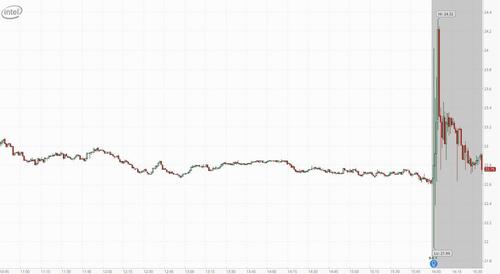
Intel Finally Beats On Revenue, Gives Upbeat Forecast
For what may be the first time in years, Intel – once the world’s most successful and iconic chip maker, and now a pale shadow of its former self and stock market laughing stock that has missed the entire AI explosion – did not have a terrible quarter.
Starting with the Q2 results, the chip giant reported revenue of $12.9 billion, up 0.2% YoY, and well above estimates of $11.9 billion. Sales of chips used in PCs also beat estimates, benefitting from President Trump’s import tariff announcements, as major customers rushed to buy chips for laptops and desktop PCs – a market that has recently seen rising pressure from competitors like AMD – ahead of the levies taking effect.
Intel’s client computing division had revenue of $7.9 billion last quarter, topping the average prediction of $7.3 billion. Data center sales were $3.9 billion, compared with a $3.7 billion estimate. The foundry division generated revenue of $4.4 billion, in line with projections.
Adjusted gross margin was about 30% or less than half of what it was when Intel’s chips dominated the data center market. Nvidia, which dominates the market for AI chips, has margins above 70%.
The company also posted a loss of 10 cents a share, down 0.12 YoY and 0.10 below the April outlook of a flat quarter; it also missed an estimated profit of 1 cent.

Intel had previously said it planned to cut operating expenses to about $17 billion this year and $16 billion in 2026. The Santa Clara, California-based company remains on track for the 2025 cuts.
But it was Intel’s stronger-than-anticipated revenue forecast for Q3 that offered investors a glimmer of hope as they wait for a turnaround under new CEO Lip-Bu Tan.
Intel said that Q3 sales will be $12.6 billion to $13.6 billion, vs an average analyst estimate of $12.64 billion. The company also expects $0.00 EPS and a 36.0% gross margin, and increase of 18% YoY.

The solid guidance came at a time when analysts expressed concern that the strong demand for PCs from the first half of the year won’t continue. The threat of tariffs imposed by the US may have prompted PC makers to rush to stock up ahead of prospective cost spikes, the company warned last quarter.
At the same time, Intel is benefiting from a resurgence in the personal-computer industry, driven in part by manufacturers’ efforts to build up inventory before tariffs hit. But the Silicon Valley pioneer still faces a variety of challenges. It has lost market share to rivals and is struggling to attract customers to its foundry business, which makes chips for outside clients. It also lacks products that can satisfy the massive demand for AI systems.
Intel said Thursday it would refocus its strategy on the highly competitive market for AI chips, regaining market share in personal computer processors and developing its advanced 14A technology to sell to large customers.
Intel, which has long dominated the business of making chips for laptops and desktop computers, fell far behind competitors like Nvidia, Advanced Micro Devices and Taiwan Semiconductor Manufacturing Company after it failed to anticipate the surge in demand for the powerful chips fueling the artificial-intelligence boom.
„There are no more blank checks,” Intel Chief Executive Lip-Bu Tan wrote in a memo to staff. „Every investment must make economic sense.”
Tan, who took the CEO job about four months ago, has been working to cut costs and reestablish Intel’s engineering-focused culture. The effort has included layoffs and the scaling back of a once-massive factory expansion.
Intel further tapped the brakes in its earnings report on Thursday, saying it had canceled already-paused projects in Germany and Poland. The company will slow the pace of construction at a planned Ohio facility as well.
The layoffs will reduce staff by 15%, and the company expects further cuts through attrition and the splitting off business units, CFO Dave Zinsner told BBG in an interview. The chipmaker aims to end the year with 75,000 employees, down more than 20% from the end of the June quarter. Bloomberg News reported in April that Intel was looking to cut its workforce by roughly that amount.
Demand was stronger than expected last quarter because an economic slowdown didn’t materialize, Zinsner said. But the company is aware that some demand might have stemmed from consumers and businesses trying to avoid tariffs.
“We felt like tariffs might be a headwind in the second quarter and would further unsettle the economy,” he said. “None of that transpired.”
The chip-making giant said Thursday it would refocus its strategy on the highly competitive market for AI chips, regaining market share in personal computer processors and developing its advanced 14A technology to sell to large customers.
Intel’s CFO said a new production technique called 18A is progressing well and that more competitive chips will start to come out of its factories toward the end of the year. A successor technology called 14A will follow and be better suited to trying to attract outside customers. At the same time, Zinsner said the company isn’t yet ready to unveil AI-related gear. The chipmaker is focusing on the development of products that will fit in unserved parts of the market.
Tan’s predecessor, Pat Gelsinger, had concentrated on expanding Intel’s factory network, once its key competitive advantage. He laid out plans to spend tens of billions of dollars on making its plants the best in the industry again, a status that would force rivals to use it as an outsourced provider of manufacturing.
For now, the biggest user of its factories is Intel’s internal design teams. Some of Intel’s best offerings now contain components made by Taiwan Semiconductor Manufacturing, adding more pressure to its margins.
Intel, which has long dominated the business of making chips for laptops and desktop computers, fell far behind competitors like Nvidia, Advanced Micro Devices and Taiwan Semiconductor Manufacturing Company after it failed to anticipate the surge in demand for the powerful chips fueling the artificial-intelligence boom.
Intel’s stock rose about 2% in extended trading following the second-quarter results. For the year, it’s up 13%. That’s in line with the broader chip industry, but trails the performance of rivals such as Nvidia Corp. and Advanced Micro Devices Inc.

Tyler Durden
Fri, 07/25/2025 – 06:55














